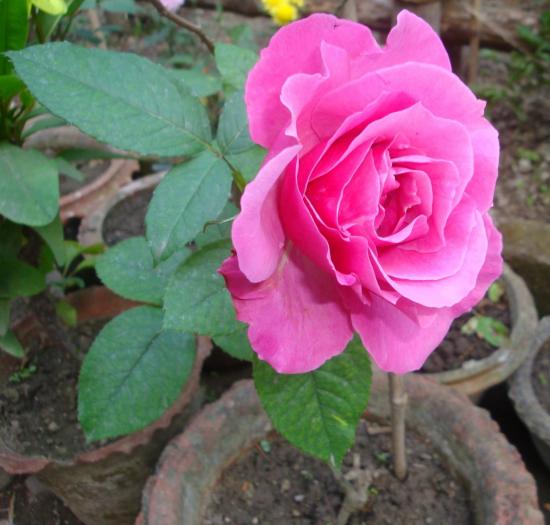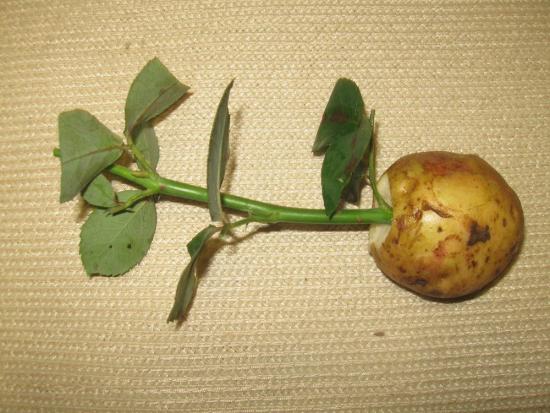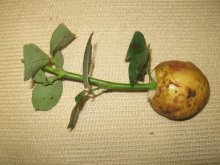How to propagate roses by cuttings: how to prepare the plant for propagation

Propagating roses is an interesting and exciting process for many novice gardeners. In order for the plant to delight with beautiful buds, it is important not only to properly prepare the cuttings for planting, but also to carry out care measures. Reproduce You can grow a rose from cuttings within 1-2 seasons if you follow all the recommendations.
Content:
- Propagation of roses by cuttings: description
- Plant preparation and propagation period
- Methods for propagating roses by cuttings: description
- Necessary conditions for rooting cuttings
Propagation of roses by cuttings: description
The procedure for propagating roses by cuttings is the simplest and most affordable way to propagate flowers. This technology allows you to obtain your own roses. Vegetative propagation has high rates rooting.
In addition, self-rooted roses are very adaptable to growing conditions and do not develop into shoots.
This method of propagation is used for vigorous roses: climbing roses, floribunda, etc. In most cases, such roses have a weak root system, and rooted strong cuttings do not produce wild shoots. To get new plants, cuttings must be done correctly.
Plant preparation and propagation period
To begin with, you should choose a rose with a strong stem. If the flower is weak, the leaves are not alive, and the stem is thin, then this is an unsuccessful propagation material. Cut off shoots that are ready to grow.This can be determined by the formed axillary buds.
Each cutting should have 2-3 buds. The cut in the upper part should be 2 cm above the bud, and in the lower part it should be directly under the bud. Tools must be well sharpened, otherwise you can injure plant tissue. The lower leaves should be completely removed and the upper leaves should be shortened. Length cuttings should be about 20 cm.
Immediately before planting, the lower cut is treated with a growth solution. Before you start cuttings, you should know what time to carry out this activity. The procedure can be carried out in the interval between the formation of the bud and before the dropping of its petals. If cuttings are carried out earlier, the wood may not be mature.

At a later date, the buds will begin to awaken, and during this period it is strictly not recommended to propagate roses. Many gardeners carry out cuttings in the fall, since the cuttings take root more easily during this period. The rose is preparing for winter and substances in the plant accumulate in large quantities. The end of spring and the beginning of summer are also considered a favorable period.
Description of the method of propagating roses by cuttings
There are several ways to take rose cuttings. You can choose one of the suitable options and use it to propagate cuttings: Rooting in the soil. You need to dig a trench to a depth of about 15 cm.
You should choose a place where there will be no direct sunlight. Next, pour coarse sand onto the bottom. Place the cuttings in the sand so that 2/3 of the plant is below the soil level. Then compact the sand around it, cover it with soil and compact it again. They need to be watered periodically throughout the summer. Already in October you can prepare for transplantation.
Rooting in potatoes. Cuttings can be carried out in open ground or at home by planting them in a pot. Fill the container with a nutritious mixture and moisten well. Next, cut the potato tuber in half and make holes in it commensurate with the diameter of the cuttings.
Then place the cuttings in a tuber and cover with a plastic bottle to create a greenhouse effect. Place the container in a warm place out of direct sunlight. Rooting using the Burito method. After preparing the cuttings, they are wrapped in damp paper. Leave in a dark place at a temperature no higher than 18 degrees.
Video about propagating roses by cuttings:
Rooting in water. The cuttings are placed in distilled water. Every 2 days you need to add water or change it if necessary. Transplantation is carried out with the appearance of roots. This usually takes about a month.
Rooting in moss. You need to buy moss in a special store. Put it in a bag, insert the cuttings into the moss and inflate the bag. Next, tie and hang. The appearance of roots can be observed after 3-4 weeks. The moss will be moistened by condensation that will accumulate during this period.
Rooting in vermiculite. This method is good because it does not require transplants rooted cuttings. Make small depressions in the pot with soil and pour vermiculite into them. You can use coconut fiber instead. Next stick in the petioles.
After some time, the roots will begin to grow through the vermiculite. Each method has its advantages and disadvantages, so the choice of rooting method must be approached responsibly.
Necessary conditions for rooting cuttings
For rooting to occur, it is necessary to provide optimal conditions for growth.In the first 15-20 days, you need to create greenhouse conditions. It is also necessary to ensure that the cuttings receive sufficient moisture, light and heat.
You need to water the soil moderately, avoiding waterlogging, otherwise this may cause rotting. The air humidity in the greenhouse should be at 80-90%. There must be droplets on the leaves. You should also regularly spray the cuttings with a spray bottle. Periodically, the greenhouse should be opened for ventilation so that the air does not overheat.

After rooting, the shoots can be transplanted into small containers. As a primer for reproduction you can take the following soil mixture: turf - 2 parts, leaf soil and sand - 1 part and a little humus. This lightweight and breathable soil promotes rapid rooting of cuttings. By following simple recommendations, you can get beautiful rose buds in the first season.











Comments
Roses can be planted from cuttings, they take root and grow, but the frost resistance of such flowers is very low. Therefore, it is better to graft a cultivated rose bud onto a rosehip bush; the bush will grow well and will not freeze.